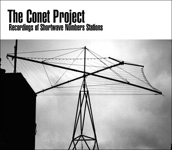|
|
 |
Dusted Reviews
Artist: V/A Album: The Conet Project Label: Irdial Disc Review date: Aug. 26, 2004 |

|
|
|
 |
In Midnight’s Children, Salman Rushdie uses a recurring dream metaphor of numbers marching to portray the tide of humanity which one must swallow to understand just one individual. Paradoxically, the image renders individuality insignificant by the brute force of such a persistent and relentless increase. The same contradiction is at the heart of that multivalent phenomenon known as The Conet Project, a four-disc set of short-wave radio recordings recently re-released by Irdial Disc. Its legend precedes and follows it, and its huge scope and singular purpose renders it formidable, but its final effect may be most apparent when considering what it is rather than the sounds contained therein.
Briefly – and brevity is necessary, because volumes have been devoted to this subject – The Conet Project is the brainchild of Akin Fernandez, an obsessive type who, in the early 1990’s, stumbled across some suspicious and chilling stations on his shortwave radio. All he heard, and logged through the sleepless nights in his London apartment, were multiple series of numbers – sometimes intermingled with snatches of familiar music, repeated tone patterns or seemingly random verbal signals. No one wanted to admit what Fernandez slowly discovered--that the purpose of these so-called “numbers” stations was the public transmission of secret messages. Fernandez was told that the numbers were coordinates to guide delivery planes, but far from satisfied, he continued to log his own observations and to seek out similarly interested short-wave aficionados who’d encountered and recorded the same phenomenon. The result, released on his own Irdial Disc label, was this encyclopedic set of numbers stations recordings. The effort bankrupt his label, but that story, and the eventual financial settlement with Wilco that brought about this re-release, is well documented in a Washington Post article of August 3rd, 2004.
In that article, Fernandez, whose label deals primarily in the avant-garde, states that rock and roll using traditional instruments is a dead trope, the worn-out path trod by our fathers, apparently implying that Conet is a logical step in the music’s evolution. This argument, enticing though it is concerning rock, falls somewhat flat in the face of 20th century musical history. The Conet Project is certainly not the first large-scale piece of music to use short-wave broadcasts as an integral part of the compositional fabric. Stockhausen’s Hymnen of 1967-68 compiles broadcasts from around the world in a very similar manner, his endeavor being focused around national anthems but making similar use of buzz and static. Hymnen has been followed by other less ambitious short-wave experiments in the 80’s and 90’s, so where aesthetics are concerned, Conet breaks no new ground. That said, its purpose may be further reaching than that of Hymnen, whose MO is ultimately a brand of unity. Conet makes no such claim, willfully employing diversity for its own sake and to demonstrate the global nature of the numbers stations, the only unity being in the numbers themselves.
The results sound as diverse as one might imagine. The voices, mainly computerized, present the illusion of ranging from the absolutely monotonous to the ultra-expressive, one mechanized woman sounding as if she’s consciously seducing the listener with every number. We hear the disembodied voices of children, old men, vivacious Asian women and wise BBC female voices in many languages and all in the service of the marching numbers. The various types of interference – drones, buzzes, bleeps and voice distortions, often in repeating patterns, do create a certain post-rock/ambient gestalt, suggesting that hip listeners are finally catching up with Conet or that it’s catching up with their own expanding musical sensibilities.
It’s hard to avoid subjectivity when reviewing a set like this. How would one review, for example, a thunderstorm, even a recorded one? It exists, and while the damage can be assessed, its ultimate purpose lies outside of the artistic. Still, Conet’s importance as a document of a previously unexplored facet of espionage cannot be overstated, and listening to it while reading the extensive booklet can be a frightening and overwhelming experience. “The Sexy Lady” and the non-sequiturial insertion of familiar tunes can be disconcertingly humorous. Finally, the numbers march so insistently that they become non-entities, something to be transcended if not overlooked. They become mundane, and perhaps that’s the most chilling aspect of Conet’s legacy – that they continue unabated, serving whatever purpose, good or ill, of which we are still largely unaware.
By Marc Medwin
|







